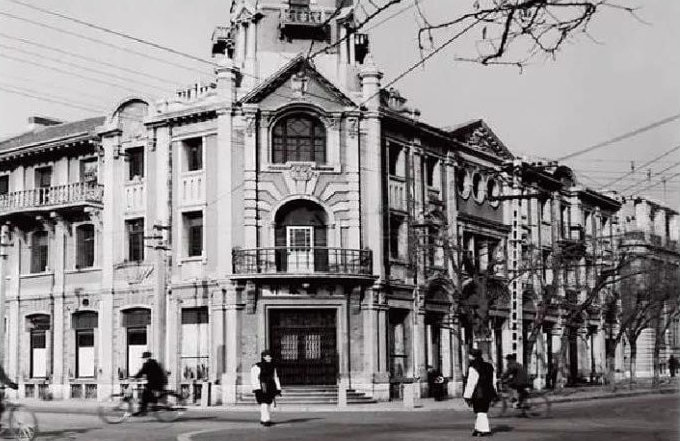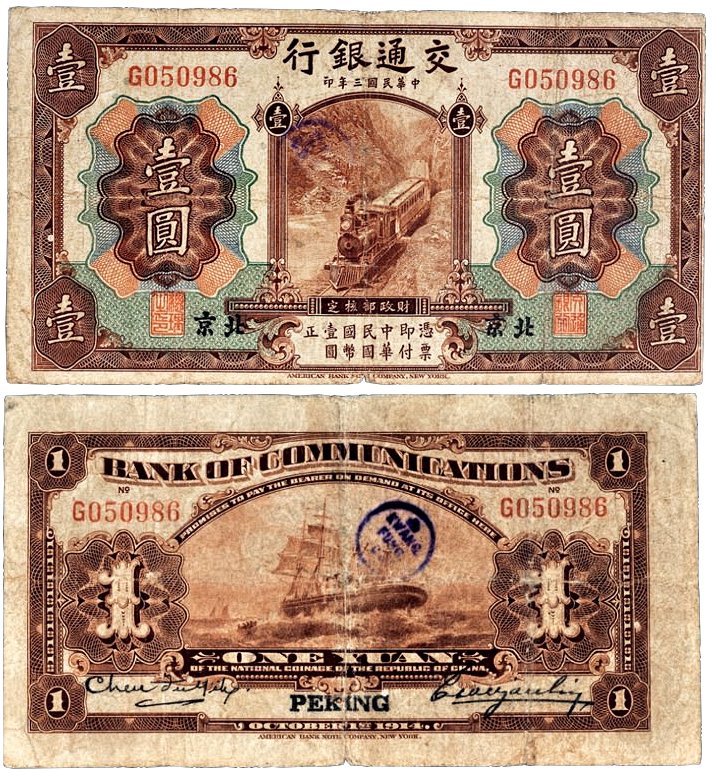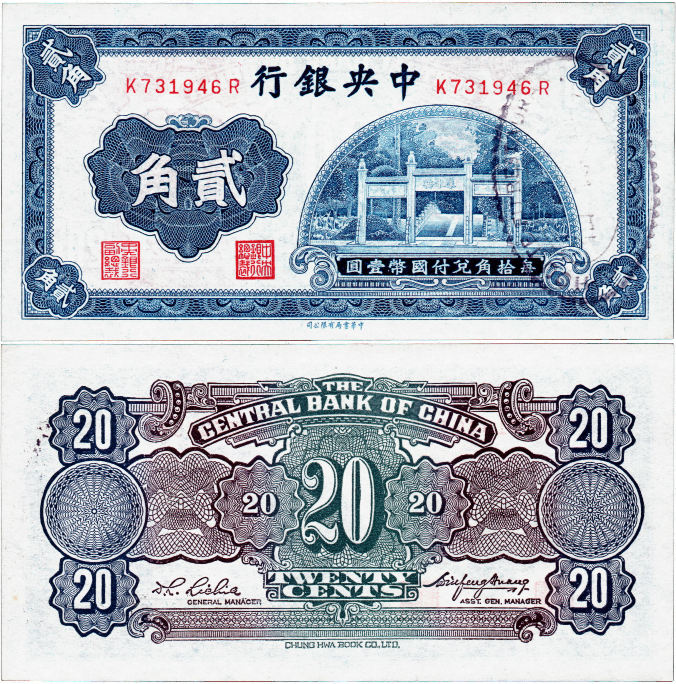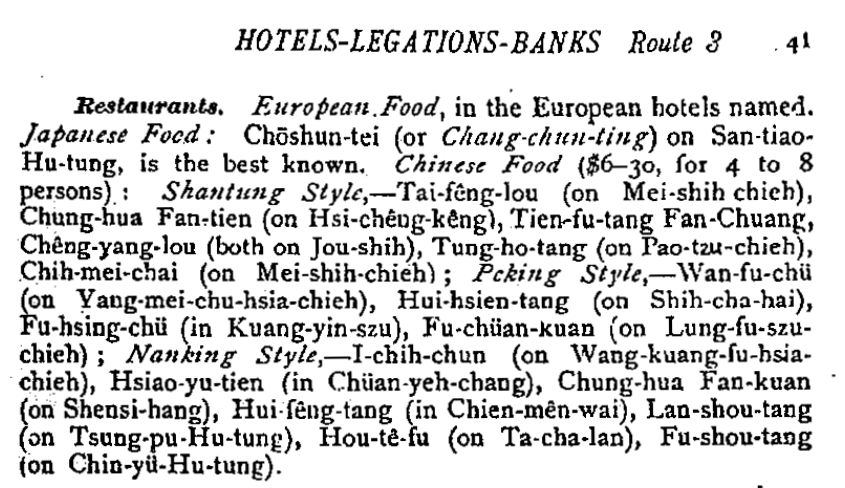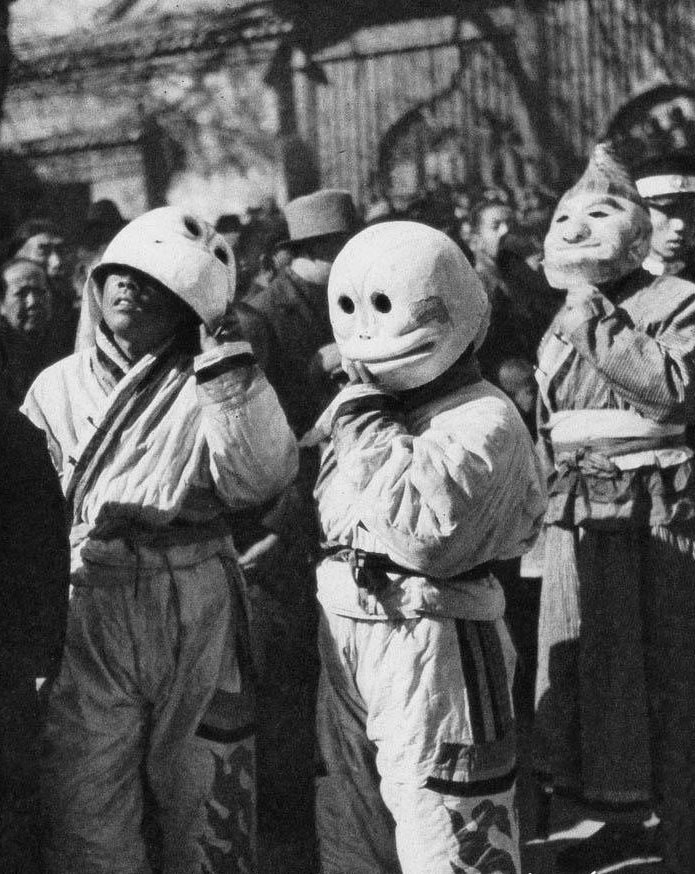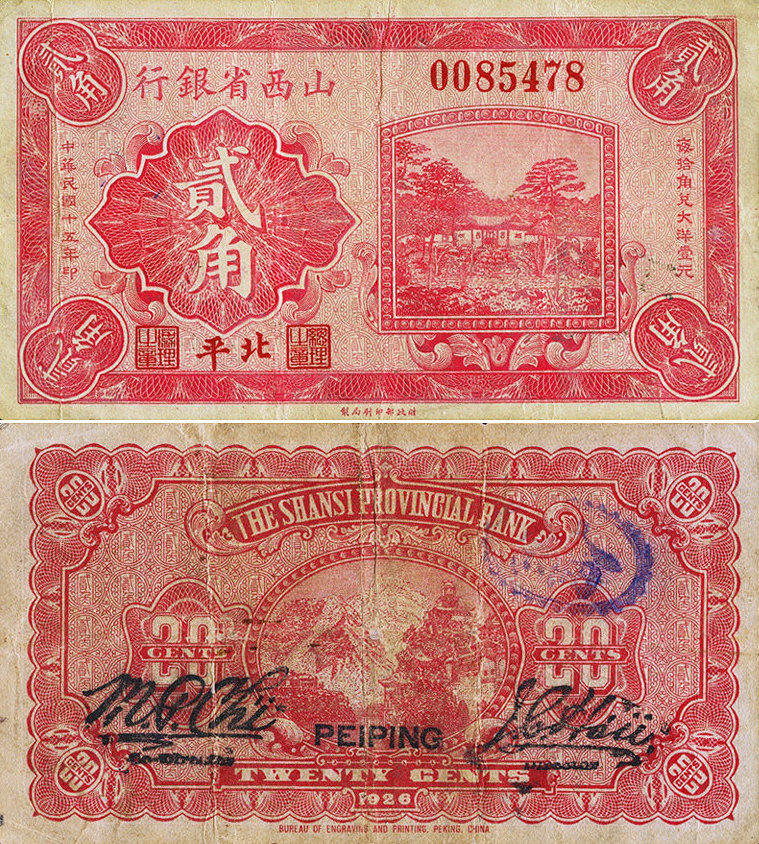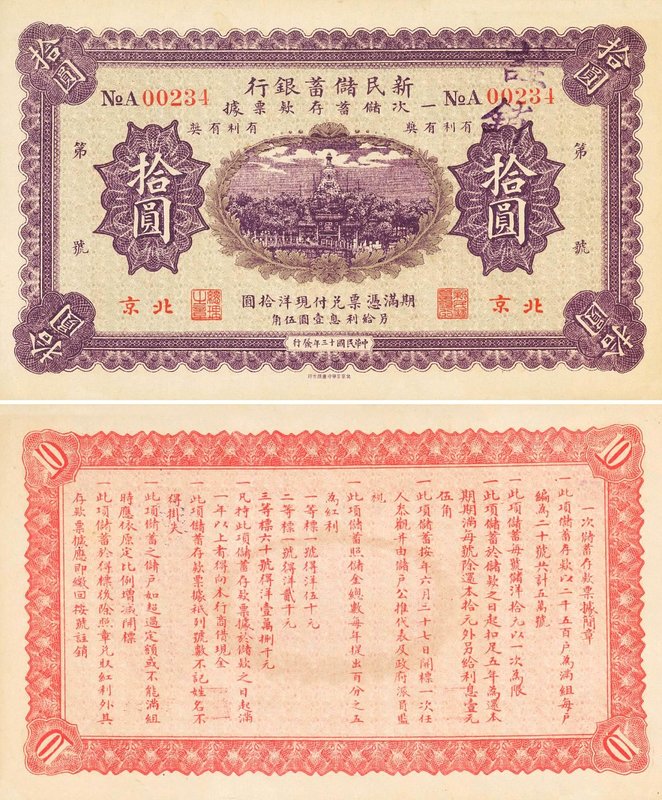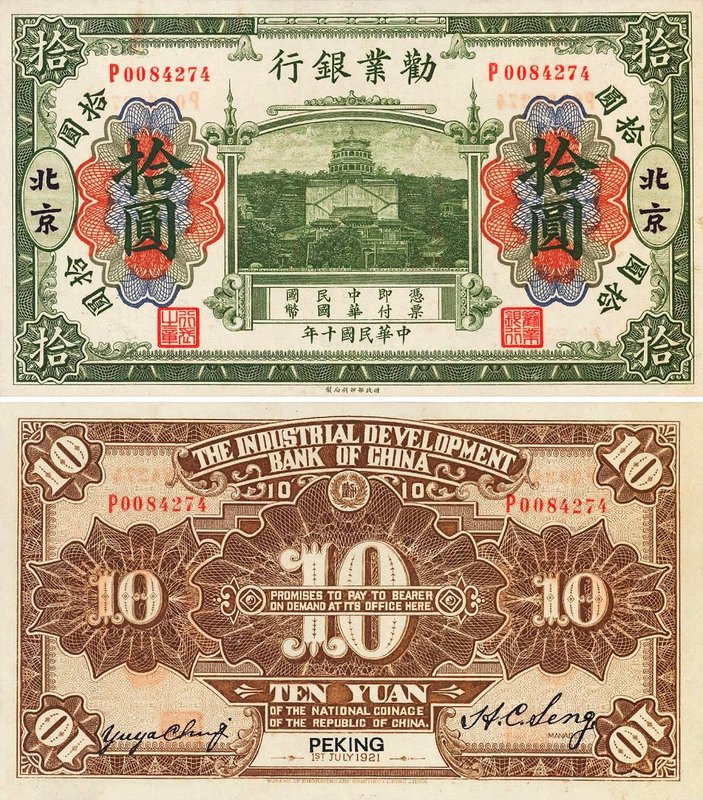Peking - Beijing - 北京 |
Updated January 26 2021
|
Peiping - Beiping - 北平
Section 2: The Currency
Peking's role in the history of Chinese paper money, especially after the 1920s, is important but not as readily evident as may be expected due to the political and financial upheavals during the 20th century. A significant proportion of Republican China's government, regional and commercial currencies were produced in Beijing at the Bureau of Engraving and Printing, Peking, and later by the Japanese using the facilities of such for some of the issues of the Federal Reserve Bank of China.
The Money
The Bank of China 中國銀行
|
The Bank of China was founded at Shanghai in 1912, out of the re-organised Ta-Ching Government Bank, though it was based in Peking until 1928. Following the movement of the capital to Nanking, the bank was reorganised, and it's headquarters were relocated to the emerging financial 'capital' at relatively nearby Shanghai.
Right: apparently an image of the Bank of China's Peking branch, c1920s |
|
Right: Bank of China Peking branch 1912 provisional issue $1 on notes created for it's predecessor, the Ta Ching Government Bank, of 1909. The portrait is of the important Qing politician, general and diplomat Li Hong Zhang (1823-1901). From later in 1912, redesigned versions of this series would be issued with the new Bank of China titles, and the portrait replaced with that of the deified mythical ancient emperor Huang-Di (The Yellow Emperor). All were printed by the American Banknote Company, though the overprints were presumably applied in China. The later issues would retain the vingettes; the one facing Li is based on an 1890s photograph of a train emerging from a tunnel (not shown) on a stretch of the newly built Peking to Hangkow Railway close to the Yellow River. The back vignette depicts a tree-lined section of the Grand Canal (Beijing–Hangzhou). |
|
Above: Japanese officers in Peiping, 1937.
|
Above: US sailor from the 'Huron' in Peking, c1900s.
|
The Bank of Communications 交通銀行
|
Founded at Peking during 1907-08 (the 34th year of the reign of Guangxu), this government bank soon emerged as one of the first few major national and note-issuing banks in the early days of the Republic of China.
In c1925-27 the Peking branch was downgraded with the Tientsin (Tianjin) branch becoming the sole regional branch of issue. The bank was reorganised and the headquarters relocated to Shanghai in 1928. This was due to Peking no longer functioning as a political or commercial centre following the relocation of the capital to Nanking (Nanjing), and the ongoing rise of Shanghai as China's financial centre. Right: the Peiping Sub-branch, completed in 1932, located in the West Riverside outside the Qianmen, taken in 1935. |
The Central Bank of China (1928) 中央銀行
|
This important national bank became the sole official issuer of paper currency in the KMT controlled Republic of China from 1942 (see the Shanghai section for more information). It did not issue Peking specific branch issues, however occasionally notes appear which were chop marked by businesses in the city, attesting to their circulation there. Such provide a little snippet of a notes normally unknowable history. Right: an almost uncirculated 20 cents first issued c1935-1936 (not 1931 as stated in catalogs). This depicts the gates to the Zhu river bridge at Kong Lin (the Confucius Forest), Kufu (Qufu), Shantung (Shandong). The right side of the front carries a scarce but very faint chop by a Peking restaurant: 'Hou Te Fu Restaurant' 厚德福, Ta-cha-lan Street, (in south?) Peiping (Peking, Beijing). Apparently a well known establishment, it sold 'Nanking style' food. Below left: the enchanced though still difficult to read chop or stamp. The Chinese characters across the centre are barely there. The 'PEIP...' of Peiping can be made out along the bottom. Below right: the brief entry for Peking restaurants in a c1910s-1920s guidebook, which mention the restaurant in the bottom two lines, 'Hou-te-fu'. |
The Federal Reserve Bank of China 中国聯合準備銀行
|
The bank was established March 7th 1938 with a capital of 50 million yuan, to serve the Japanese puppet administration which controlled much of northern China, 'The Provisional Government of the Republic of China,' which had been officially inaugurated on December 14th 1937. By the end of 1938 the bank had already issued 162 million yuan in banknotes. The Issues of the Federal Reserve Bank of China were unpopular to the point that the Japanese resorted to extreme measures of threats and intimidation. One reported example of June 1938, is of a military plane dropping leaflets over Tientsin (Tianjin) which stated that anyone found in possession of currency other than that of the bank after June 10th would have their ears cut off! Unfortunately for the populace caught between the factions, the threats by Nationalists and Communists for using these notes were equally as violent. Disgruntled Chinese were known to refer to this currency as 'traitors notes'. Upper Right: The second version 100 Yuan of 1938, depicting Huangdi and printed at the Bureau of Engraving and Printing, Peking, using (mostly) designs created for an unissued Qing Imperial banknote series of c1908 for the Ta Ching Government Bank (which became the Bank of China). The portrait replaces that of Prince Chun, father of Pu-Yi (the last emperor) used on the original designs. This note was re-issued during 1944-1945 with a simplified reverse design. Right: a specimen version of the Ta Ching notes, most likely developed to advertise the work of the Bureau. The name of the printer has replaced that of the bank on the front. Smith and Matravers observe in their 1970 catalogue that this is most likely the version shown to officials of the newly formed Federal Reserve Bank. |
The Market Stabilisation Bureau - The Ministry of Finance 财政部平市官錢局
|
Apparently issues of the Republic/Beiyang Government of Peking, Ministry of Finance, for municipal circulation (Bureau of the Ministry of Finance Municipal official money), for which there appears to be little information available in English, if at all. The China Year Book for 1919 has this entry which appears to refer to this issuer: "The Ping-shih (Market Adjustment) Bank of the Finance Ministry was established in the third year of the Republic (1914) at Paoting, and in Peking and Tientsin in 1916. It issues copper coin notes." Right: a 10 coppers Peking issue of 1921. The note depicts the Summer Palace with the Marble Ship (Shifang) at left, and the Temple of Heaven at right. The purple chop on the back was applied by the Bureau itself. |
Hopei Metropolitan Bank / Hopei Money Bureau - 河北銀錢局
|
Based at Pao-Ting (Baoding). According to the Kyoto University Economic review (vol.15) of 1940, these notes were actually issued by the Provincial Bank of Hopei in the name of the Metropolitan Bank. Right: 10 copper coins (National Currency) of 1936, stamped for Peking issue/redemption. The vignette depicts the Garden of Harmonious Interests (Xiequyuan 谐趣园) at the Summer Palace in Peking (Beijing). Printed by the Bureau of Engraving and Printing, Peking. |
Miscellaneous provincial and commercial banks
|
Above: The Peiping Municipal Bank 北平市銀行, founded in 1936. 2 Cents national currency, 1937. Printed by the Bureau of Engraving and Printing, Peking.
|
Above: The Shansi Provincial Bank 山西省銀行 was established in 1919 by the warlord Yan Hsi-Shan. 20 Cents of 1926. The use of 'Peiping' demonstrates that this note wasn't issued until at least 1928, most likely during Yan's occupation of Beijing in June of that year in aide of Chiang Kai-shek, which brought the Northern Expedition to a successful conclusion.
|
|
Above: The New People's Savings Bank 新民儲蓄銀行 - Peking - 10 yuan of 1924 depicting the Beihai Park White Dagoba in Peking (Beijing). A local small commercial bank of which nothing is known.
|
Above: The Industrial Development Bank of China 勸業銀行 - Peking branch 10 Yuan of July 1st 1921. The bank was founded in c1914 by Chang Chien (Zhang Jian). It ceased issuing notes after 1928.
|
The Sino-Scandinavian Bank 華威銀行
|
In spite of the name; the Sino-Scandinavian Bank, it was a Norwegian - Chinese operation. The "Scandinavian" may have come from the wish of the Chinese authorities to attract Swedish and Danish capital and trade. The funding was mainly raised by Chinese parties, but some funding also came from Norwegian sources. The bank was chartered by the Chinese government on July 21st 1921. The inaugural meeting took place in the main branch office's premises in Peking (Beijing) on September 1st. Operations started on January 7th 1922. The bank had branches in Shanghai, Tientsin and Kalgan. The bank probably went out of operation due to bankruptcy between October 8th 1926 and July 1st 1927. Source: Janeriks.no Right: the 10 Yuan issue of February 1st 1922, printed by the Bureau of Engraving and Printing, Peking. The front depicts the Summer Palace, and the back; a viking ship. Interestingly, this was intended for Tientsin issue but has been amended for circulation out of the Peking branch. |
Credit Commercial Sino-Francais 中法振業銀行
|
A short-lived Sino-French banking enterprise that was based in Peking. It is listed in the 1922 edition of 'The Peking Who's Who' has having 2 million in capital. There seems to have been only the one currency series issued; the 1, 5 and 10 yuan of 1923 produced by the Bureau of Engraving and Printing, Peking. The Chinese Economic Bulletin in 1924 mentions a branch office opening at 64 Tientsin Road, Shanghai. This branch is listed in the 1925 edition of the Comacrib Directory of China. Right: the 10 Yuan 'Local Currency' issue of 1923. The Chinese building on the front is not yet identified though is most likely located in Peking. The reverse vignette is the almost incongruous depiction of the Arc de Triomphe in Paris; though logical enough a choice for a French backed bank. |
Above: a folding postcard depicting a camel train passing the walls of Peking. This image was used by the American Banknote Company as the basis of the front vignette of the 1918 series for the Asia Banking Corporation.
